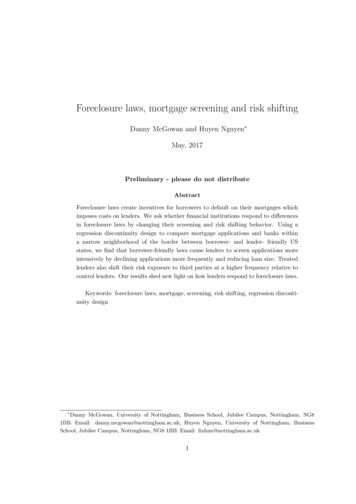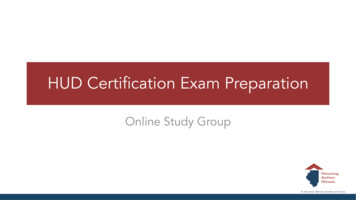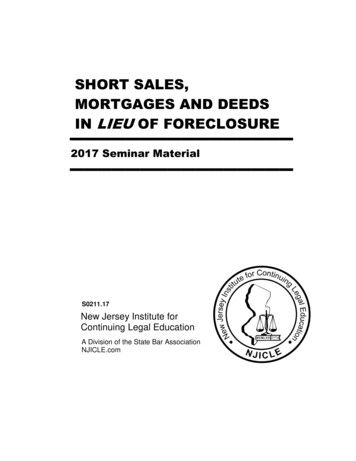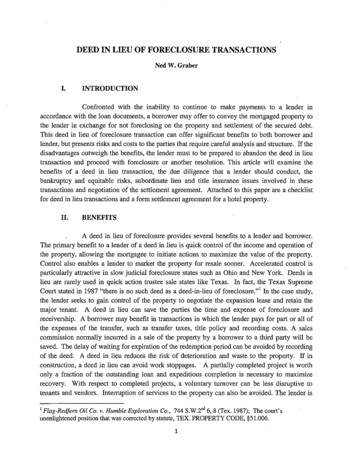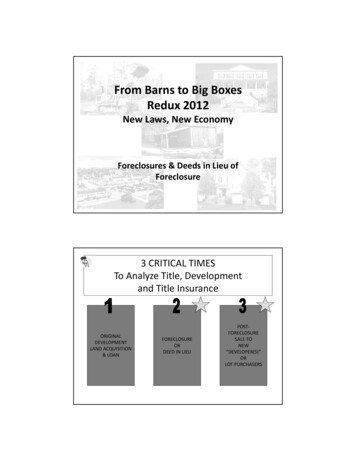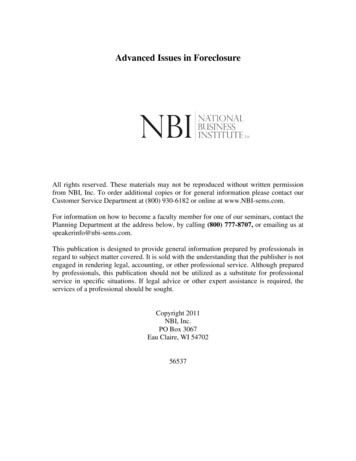
Transcription
Advanced Issues in ForeclosureAll rights reserved. These materials may not be reproduced without written permissionfrom NBI, Inc. To order additional copies or for general information please contact ourCustomer Service Department at (800) 930-6182 or online at www.NBI-sems.com.For information on how to become a faculty member for one of our seminars, contact thePlanning Department at the address below, by calling (800) 777-8707, or emailing us atspeakerinfo@nbi-sems.com.This publication is designed to provide general information prepared by professionals inregard to subject matter covered. It is sold with the understanding that the publisher is notengaged in rendering legal, accounting, or other professional service. Although preparedby professionals, this publication should not be utilized as a substitute for professionalservice in specific situations. If legal advice or other expert assistance is required, theservices of a professional should be sought.Copyright 2011NBI, Inc.PO Box 3067Eau Claire, WI 5470256537
Complex Commercial Foreclosure Issues:A Review Of California Foreclosure Law RegardingPossession And ReceivershipSubmitted by Terrance J. Evans53
Complex Commercial Foreclosure Issues:A Review of California Foreclosure Law RegardingPossession and ReceivershipBy Terrance J. Evans, Esq.During the foreclosure process, lenders are often very concerned about thepreservation of their real property collateral, and their ability to prevent a defaultingborrower from impairing or depleting the rents and/or profits from the estate. In order toproperly strategize regarding how to deal with these complex issues, it is important tounderstand the pertinent legal issues involved. In this article, we will examine possessionand receivership issues under California law.I.Lenders Have Limited Rights to Possession and RentsA mortgage or deed of trust provides a lender or creditor with a lien against thedebtor’s interest in the real property collateral, which can be satisfied through a judicialor nonjudicial foreclosure on that security interest. See, Roger Bernhardt, CaliforniaMortgages, Deeds of Trust, and Foreclosure Litigation §6.1 (4th ed. 2011).Nevertheless, prior to foreclosure, the lien by itself does not give the lender anyindependent right to possession of the real property collateral (see Bernhardt, supra at§6.1; see also People's Sav. Bank v Jones, (1896) 114 Cal. 422) or to the rents derivedfrom the property (see Bernhardt, supra at §6.1; see also Lee v Ski Run ApartmentsAssocs., (1967) 249 Cal. App. 2d 293). Cal. Civ. Code §2927; Cal. Code Civ. Proc. §744.Under California law, if the loan documents do not contain an assignment of rentsclause or an analogous provision, a default by the debtor does not deprive the debtor ofpossession of the property or its rents until after a foreclosure has been completed. SeeBernhardt, supra at §6.1. The result would be completely different had the default1 of 1754
occurred in one of the title theory states, which hold that a mortgage gives the creditortitle to the mortgaged property (and therefore to its possession and right to rents from thepossession). Id. at §6.1.However, California follows a lien theory regarding rents, even when a deed oftrust is involved, which means that absent an assignment of rents provision a lender doesnot have a right to collect rents from the real property collateral until a foreclosure saleextinguishes the debtor’s title. See Bernhardt, supra at §6.1; see also Kinnison vGuaranty Liquidating Corp., (1941) 18 Cal. 2d 256. Additionally, without speciallanguage in the security instrument, the creditor has no right to possession before theforeclosure sale. Bernhardt, supra at §6.1.1A.The Effect Of An Assignment of Rents ClauseInstitutional lenders making loans in California typically use standardized loandocuments and deed of trust forms that contain an assignment of rents clause. Id. at §6.2.Essentially, an assignment of rents clause in a deed of trust gives the beneficiary a rightto collect rents immediately upon the trustor's default. Id. at §6.2. Assignment of rentsprovisions are regulated by statute in California, and must be enforced in a courtreceivership action . Id.The remedies available to a beneficiary upon the default of a debtor will besubstantially enhanced or limited depending on whether or not the security instrumentcontains an assignment of rents provision. Bernhardt, supra at §6.2.It comes as no surprise that a defaulting debtor in possession of real propertycollateral is less likely to maintain, secure, and/or insure the property after defaulting on1Please note that following a judicial foreclosure sale, the purchaser is entitled to rents but not possessionuntil expiration of the redemption period. Bernhardt, supra at §6.1.2 of 1755
the loan. Id. Furthermore, since an uncontested foreclosure in California can take at leastfour months to complete, and a contested foreclosure involving litigation and bankruptcycan take over a year to complete, there is a serious risk that the defaulting debtor willallow the real property collateral to deteriorate during the lengthy foreclosure process.Id. Such a scenario could seriously jeopardize the value of a lender’s real propertycollateral. Additionally, a defaulting debtor may attempt to collect rent and profits fromthe real property collateral during the foreclosure process without making any attempt tocure the outstanding default on the delinquent loan. Id. Assignment of rents and profitsclauses are designed to prevent such "waste" and "skimming." See Bernhardt, supra at§6.2; see also U.S. v Haddon Haciendas Co., (9th Cir 1976) 541 F. 2d 777; see alsoCornelison v Kornbluth, (1975) 15 Cal. 3d 590.B.Using A Receivership In The Workout Of A Defaulted LoanIn light of the ongoing financial crisis in the United States, lenders areincreasingly using receiverships to address and resolve issues arising from defaultedcommercial loans. See Bernhardt, supra at §6.2AThe resulting transaction is called a “workout.” Id. However, this is not atraditional workout between the defaulting borrower and the lender or special servicer buta sale in which a third party purchases the real property collateral subject to the existingdeed of trust and assumes the existing loan. Id. The principal balance of the loan may bemodified to reflect the sales price or some other restructuring of the existing debt mayoccur. This is especially important for Commercial Mortgage Backed Securities loans(“CMBS loans”), which are held in Real Estate Mortgage Investment Conduits(REMICs). See Bernhardt, supra at §6.2A. Since the federal tax rules and contracts thatgovern REMICs typically forbid them from issuing new debt, a receivership sale and an3 of 1756
assumption of the loan allows lenders and special servicers an alternative to foreclosureand resale. Id. Additionally, a receivership can provide the following advantages:!The lender does not have to wait until after the foreclosure process toremove the defaulting borrower as the manager of an income-producingproperty or a project under construction; Id.!The appointment of a receiver reduces the risk of rent skimming andwaste; Id.!A receiver taking over a project under construction will have the authorityeither to complete the project or to shut it down and secure it if completionis not feasible (lending institutions do not usually have the experience todo this effectively without outside assistance); Id. and!When the court gives the receiver authority to sell the property through amultiple listing service (MLS) by a real estate broker, in most cases thesale will net significantly greater proceeds than a foreclosure sale (thisalternative also allows the lender to avoid holding the property in thelender's REO (real estate owned) inventory). Id.Bernhardt, supra at §6.2A.Notwithstanding the above noted advantages that selling a property subject to theloan may provide to CMBS trusts and their servicers, this approach is not entirely withoutrisk. See Bernhardt, supra at §6.2A. During the negotiating process, the defaultingborrower may stipulate to the appointment of the receiver and consent to the receiver'ssale of the property to a new buyer in exchange for a complete or partial waiver from thelender of a deficiency judgment or a complete or partial reduction in the guarantor'sliability under the guaranty. Id. However, if the defaulting borrower does not consent,California's one-action rule, which is set forth in Cal. Code Civ. Proc. §726(a), andCalifornia’s antideficiency protections raise the following questions:4 of 1757
!Is the receiver's sale a judicial foreclosure? If a judge were to find thata receiver's sale of a distressed property subject to a lien securing a loan indefault is not a de facto foreclosure, then the lender risks not qualifying fora deficiency judgment because of not having (1) proceeded by judicialforeclosure, (2) sold the property subject to the post sale statutory right ofredemption (an essential antideficiency protection), (3) applied for atimely deficiency under Cal. Code Civ. Proc. §726(b), or (4) satisfied thefair value process. Bernhardt, supra at §6.2A.!Does the fact of court authorization of the receiver's sale precludeapplication of the one-action rule? See Aplanalp v Forte, (1990) 225Cal. App. 3d 609; judicial offset of verdict in favor of borrower againstdebt owed to lender violated Cal. Code Civ. Proc. §726(a)). Bernhardt,supra at §6.2A.!Does the exemption from the one-action rule under CCP Cal. CodeCiv. Proc. §564(d) apply? The order appointing the receiver may permitthe receiver to sell the property (see Cal. Code Civ. Proc. §568.5) if themoving party shows that an imminent financial crisis will occur if the saleis not made. But the power to sell under §568.5 is not expresslymentioned in Cal. Code Civ. Proc. §564(d), which only provides that anaction by a secured lender to appoint a receiver under California'sreceivership law is not an "action" for purposes of CCP Cal. Code Civ.Proc. §726(a). Bernhardt, supra at §6.2A.!Assuming the receiver's sale is tantamount to a judicial foreclosureallowing a post sale deficiency judgment, how is the deficiencymeasured? Bernhardt, supra at §6.2A.!Even if the borrower consents to the receivership and the sale, is thisan invalid waiver of §726(a)? Bernhardt, supra at §6.2A.Bernhardt, supra at §6.2A.When a receivership action is brought for the above noted purposes, theprocedures vary depending on whether there is an assignment of rents clause in the deed5 of 1758
of trust. Bernhardt, supra at §6.2A. If no assignment of rents clause exists and the realproperty collateral is worth less than the amount owed, Cal. Code Civ. Proc. §564(b)(2)enables the lender to obtain appointment of a receiver to take possession pending ajudicial foreclosure action by showing the following two things:1. The mortgaged "property is in danger of being lost, removed, or materiallyinjured, or that the condition of the deed of trust or mortgage has not beenperformed"; Id. and2. that "the property is probably insufficient" in value to satisfy the secureddebt. Id.Bernhardt, supra at §6.2A.II.A Lender’s Right to Possession and Rents Before ForeclosureA.Mortgagee In PossessionOne option available to a lender seeking to protect against waste and reach therents is to take possession of the real property collateral, with the debtor's consent, duringthe life of the loan. Bernhardt, supra at §6.3. A secured creditor who takes suchconsensual possession of the real property collateral is referred to as a "mortgagee inpossession." Id. It is important to remember that a lender who becomes a mortgagee inpossession acquires both advantages and liabilities. Id. This status carries with itconsequences beyond those created in a normal deed of trust or mortgage. See Bernhardt,supra at §6.3.In light of the legislative overhaul and rationalization of the rents and profitsprocedures and concepts, few mortgagee-in-possession issues arise. See Bernhardt, supra6 of 1759
at §§6.3,6.20, 6.25-6.28. Many lenders take steps to avoid mortgagee in possession statusbecause of the liabilities involved. See Bernhardt, supra at §6.3.B.Rights Of A Mortgagee In PossessionIt is well established under California law that a lender who becomes a truemortgagee in possession may retain possession of the real property collateral until thedebt is paid. See Bernhardt, supra at §6.4; see also Snyder v Western Loan & Bldg. Co.,(1934) 1 Cal. 2d 697. Even when an action to collect on the promissory note would bebarred by the statute of limitations, a mortgagee in possession may remain in possessionas long as the obligation is unsatisfied. See Bernhardt, supra at §6.4; see also Spect vSpect, (1891) 88 Cal. 437. This is typically not important to the beneficiary under a deedof trust because the power of sale remedy is generally not subject to time limitations,however, classification as a mortgagee in possession can be very important to a lender orcreditor holding a mortgage or hidden security instrument that is subject to a statute oflimitation. See Bernhardt, supra at §6.4; see also Aguilar v Bocci, (1974) 39 Cal. App.3d 475.In addition to the foregoing, another reason why a lender or creditor may want tobecome a mortgagee in possession is that such possession carries with it the right to takethe rents and profits generated by the real property collateral. See Bernhardt, supra at§6.4. A mortgagee in possession may apply the profits from the real property collateraltoward payment of the debt even if there is no assignment of rents clause in the securityinstrument. See Bernhardt, supra at §6.4; see also Nelson v Bowen, (1932) 124 Cal. App.662; see also Johns v Moore, (1959) 168 Cal. App. 2d 709. Rent is consideration for theright to possess property; thus the right to receive rents belongs to the party that has the7 of 1760
right to be in possession, which is the lender or creditor when it is a mortgagee inpossession. See Bernhardt, supra at §6.4.C.Liability IssuesA mortgagee in possession is accountable to the debtor for management of thereal property collateral and is liable for failing to act reasonably and in a businesslikemanner in handling the real property and the rents collected. See Bernhardt, supra at§6.5; see also Davis v Stewart, (1944) 67 Cal. App. 2d 415. Notwithstanding itsobligations, the mortgagee in possession is not entitled to compensation for itsmanagement efforts. See Bernhardt, supra at §6.5; see also Earp v Earp, (1991) 231 Cal.App. 3d 1008, 1014. A mortgagee in possession does not ensure the profitability of thepremises but is responsible for any losses caused by its negligence. See Bernhardt, supraat §6.5; see also Murdock v Clarke, (1891) 90 Cal. 427, 438. This liability extends tojunior creditors as well as to the debtor. See Bernhardt, supra at §6.5; see also AngloCalifornian Bank, Ltd. v Field, (1908) 154 Cal. 513.By comparison, a creditor with an assignment of rents clause in its securityinstrument may obtain most of the advantages of possession without the accompanyingliabilities through the appointment of a receiver (which does not carry mortgagee-inpossession status). See Bernhardt, supra at §6.5. Rent assignment clauses are thereforeconsiderably superior to the direct taking of possession by the creditor. Id. Mortgageein-possession status is particularly dangerous if there is any risk that the real propertycollateral is contaminated because any owner or operator may be held responsible forclean-up costs (see Bernhardt, supra at §§6.54.54-4.57, 5.60).//////8 of 1761
D.Debtor’s Consent RequiredPursuant to California's Civil Code, a mortgage does not automatically entitle themortgagee to possession of the mortgaged property (as was true under the title theory ofmortgages at common law). See Bernhardt, supra at §6.6; see also Cal. Civ. Code §2927;see also Cal. Code Civ. Proc. §744.A debtor may make an independent agreement with the lender, however, to let thelender take possession of the property, either at the inception of the loan or at a later time;and no additional consideration is required. See Bernhardt, supra at §6.6; see also Nelsonv Bowen (1932) 124 Cal. App. 662. The mere entry by the lender with the debtor'sconsent is sufficient. See Bernhardt, supra at §6.6. A formal agreement is unnecessary;consent is implied, especially when the lender has entered after a default and without thedebtor's objection. See Bernhardt, supra at §6.6; see also Hooper v Young, (1903) 140Cal. 274 (deed absolute); see also Spect v Spect, (1891) 88 Cal. 437 (mortgage).Some California courts have even found that a peaceable entry may be all that isrequired for a lender or creditor to become a mortgagee in possession. See Bernhardt,supra at §6.6; see also Snyder v Western Loan & Bldg. Co., (1934) 1 Cal. 2d 697; seealso Nelson v Bowen, supra. Nevertheless, see Freeman v Campbell, (1895) 109 Cal.360. Bernhardt, supra at §6.6. A forcible entry, however, will subject the intrudinglender or creditor to liability for forcible entry and trespass rather than creatingmortgagee-in-possession status. See Bernhardt, supra at §6.6; see also McGuire v Lynch,(1899) 126 Cal. 576 (trespass); see also Calidino Hotel Co. v Bank of America Nat'l Trust& Sav. Ass'n, (1939) 31 Cal. App. 2d 295, 306, (forcible entry).//////9 of 1762
E.Entry Following Invalid Foreclosure SaleThere appears to be no clear rule regarding entry into possession subsequent to aninvalid foreclosure sale. See Bernhardt, supra at §6.7. For example, the CaliforniaSupreme Court has held that a purchaser who took possession under a judicial sale thatwas void for lack of an indispensable party was nevertheless a mortgagee in possession.See Bernhardt, supra at §6.7; see also Burns v Hiatt, (1906) 149 Cal. 617. Conversely,the California Supreme Court has also held to the contrary when the entry followed aprivate sale under a power of sale in a mortgage (as distinct from a deed of trust) that wasbarred by the statute of limitations. See Bernhardt, supra at §6.7; see also Faxon v AllPersons, (1913) 166 Cal. 707.When a lender or creditor takes possession under circumstances that do not entitleit to claim mortgagee-in-possession status, it loses all the advantages of that status. SeeBernhardt, supra at §6.7. The lender cannot retain possession to force payment of a debtthat is otherwise barred (See Bernhardt, supra; see also Faxon v All Persons, supra), andit cannot apply rents collected toward reducing the debt (See Bernhardt, supra; see alsoFreeman v Campbell (1895) 109 Cal. 360). Any money collected must be turned over tothe debtor even though the mortgage debt remains unpaid. See Bernhardt, supra at §6.7;see also Belcher v Aaron, (1937) 8 Cal. 2d 180. Thus, the lender must return to the debtorany rents, which it will likely not be able to recover thereafter because of California'santideficiency laws. See Bernhardt, supra at §6.7.F.Acts That Do Not Trigger Mortgagee In Possession StatusMortgagee-in-possession status does not result automatically simply by taking asecurity interest in land. See Bernhardt, supra at §6.8. Neither a mortgage nor a deed oftrust in and of itself gives the lender or creditor a right to possession of the real property.10 of 1763
See Bernhardt, supra at §6.8; see also Cal. Civ. Code §2927; Snyder v Western Loan &Bldg. Co., (1934) 1 Cal. 2d 697; Bank of America v Bank of Amador County, (1933) 135Cal. App. 714. Nor does a deed absolute intended as a mortgage authorize the lender orcreditor to take possession of the property unless the deed expressly so provides. SeeBernhardt, supra at §6.8; see also McGuire v Lynch, (1899) 126 Cal. 576.Physical acts of management—not merely rent collection—are required for acreditor to become a mortgagee in possession (see Bernhardt, supra at §6.8; see alsoBank of America v Bank of Amador County, supra). The creditor does not become anautomatic mortgagee in possession merely because any of the following fourcircumstances exist:1. The security documents contain an assignment of rents clause (SeeBernhardt, supra at §6.8; see also Freeman v Campbell, (1895) 109 Cal.360; Bank of America v Bank of Amador County, supra);2. The creditor personally collects rents from the tenants under anassignment of rents clause (See Bernhardt, supra at §6.8; see also Cal.Civ. Code §2938(e)(1); Strutt v Ontario Sav. & Loan Ass'n,, (1972) 28Cal. App. 3d 866, 879; but see Johns v Moore (1959) 168 Cal. App. 2d709, suggesting, in dictum and in pre-Cal. Civ. Code §2938(e)(1) context,that creditor's collection of rents would be enough to impart mortgagee-inpossession status);3. The creditor enters the premises to make repairs to preserve thesecurity (See Bernhardt, supra at §6.8; see also Gudel v Ellis, (1962) 200Cal. App. 2d 849; or4. The creditor obtains the appointment of a receiver to manage theproperty (See Bernhardt, supra at §6.8; see also Cal. Civ. Code§2938(e)(1); Tourny v Bryan, (1924) 66 Cal. App. 426; Murdock v Clarke,(1891) 90 Cal. 427).11 of 1764
If a lender convinces a debtor—following the debtor’s default—to allow thelender to collect rents without assuming responsibility for property management, thisshould not have the effect of making the lender a mortgagee in possession. SeeBernhardt, supra at §6.8. In the examples described above, the lender still must accountfor rents actually collected but is not subject to the prudent business standard that courtsapply to a true mortgagee in possession (see Bernhardt, supra at §§6.8, 6.5).III.Obtaining a Receivership When There Is No Assignment of RentsClauseA.Cal. Code Civ. Proc. §564(b)(2): Waste or Default; InsufficientSecurityWhen the deed of trust does not contain an assignment of rents clause, thebeneficiary nevertheless may have a receiver appointed to protect the property as part of ajudicial foreclosure action under Cal. Code Civ. Proc. §564(b)(2). See Bernhardt, supra at§6.15; see also Neider v Dardi, (1955) 130 Cal. App. 2d 646. In order for a creditor toobtain an order appointing a receiver as part of a foreclosure action, grounds must existfor foreclosing. See Bernhardt, supra at §6.15. It is unclear whether mere neglect of theproperty or the trustor's waste is a ground for foreclosure, even if the security instrumentcontains a covenant against waste, unless it also provides that waste is an event ofdefault. Id. Most trust deed forms contain such a covenant. Nothing in Cal. Civ. Code§2929 or Cal. Code Civ. Proc. §745 (see §§6.10, 6.14) authorizes a foreclosure on thebasis of waste alone. See Bernhardt, supra at §6.15; see also Leipziger, The Mortgagee'sRemedies for Waste, 64 Cal L Rev 1086 (1976).It is important to keep in mind that the criteria for appointment of a receiver underCal. Code Civ. Proc. §564(b)(2) are more stringent than those applicable to a receiverappointed under an assignment of rents clause in a specific performance action. See12 of 1765
Bernhardt, supra at §6.15. To obtain a receiver in a judicial foreclosure action whenthere is no assignment of rents, the beneficiary must show either of the following (SeeBernhardt, supra at §6.15; see also Cal. Code Civ. Proc. §564(b)(2)):!The property is in danger of being lost, removed, or materially injured; or!The trustor has failed to perform a condition of the deed of trust.See Bernhardt, supra at §6.15.Since the purpose of §564(b)(2) is to preserve the sufficiency of the security todischarge the debt (see Bernhardt, supra at §6.15; see also Title Ins. & Trust Co. vCalifornia Dev. Co., (1912) 164 Cal. 58, 61), under either scenario, the beneficiary mustalso prove that the property would be or is probably insufficient to satisfy the debt. SeeBernhardt, supra at §6.15. Notably, the first clause in §564(b)(2) supports theappointment of a receiver when the property is threatened by loss, removal, or materialinjury and the relative value of the property after the infliction of injury would beinsufficient to satisfy the debt. Id. If the threatened injury is considerable but would"leave enough of the property remaining intact to be ample security for the debt, the courtshould not interfere." 164 Cal at 61; Bernhardt, supra at §6.15. Thus, when applying fora receiver under this clause, the plaintiff must show not only that the property is in dangerof material injury but also that such injury would so depreciate its value that it would notafford adequate security for the debt. 164 C at 62; Bernhardt, supra at §6.15.When applying for a receiver under the default provision of §564(b)(2), it is notenough that the beneficiary show nonpayment of the debt (or other default) and a declinein the value of the security; the property value must have fallen below the unpaid balanceof the loan. See Bernhardt, supra at §6.15. This situation necessitates an evidentiary13 of 1766
showing of the property's present value. See Bernhardt, supra at §6.15; see also HiberniaSav. & Loan Soc'y v Ellis Estate Co., (1933) 132 Cal. App. 408. Because theappointment of a receiver is viewed as a harsh and drastic remedy, a clear showing thatless onerous remedies are inadequate may be required. See Bernhardt, supra at §6.15;see also Cohen v Herbert (1960) 186 Cal. App. 2d 488.The language of §564(b)(2) may be interpreted not to require a showing ofinsufficiency of security when the property is threatened by loss, removal, or materialinjury. See Bernhardt, supra at §6.15. Notwithstanding the decision in Title Ins. & TrustCo. v California Dev. Co., supra, beneficiaries may argue that requiring a showing ofpotential inadequacy of value in cases of threat to the security denies them the right tomaintain an adequate margin of security. See Bernhardt, supra at §6.15. For furtherdiscussion of margin of security, see Bernhardt, supra at §§6.15, 4.51, 5.18, 8.70-8.71;see also People ex rel Dep't of Transp. v Redwood Baseline, Ltd., (1978) 84 Cal. App. 3d662.B.A Lender Has Limited Ability To Collect Rents Without AnAssignment Of RentsA difficulty confronting a beneficiary whose deed of trust lacks an assignment ofrents clause is that a receiver appointed under Cal. Code Civ. Proc. §564(b)(2) may belimited to preserving the real property collateral from waste and may not be entitled toclaim rents except as needed to avoid waste. See Bernhardt, supra at §6.16. It isimportant to keep in mind that rents and title are different interests, and one may havetitle to property without having the right to receive rents from it. See Bernhardt, supra at§6.16; see also Walmsley v Holcomb, (1943) 61 Cal. App. 2d 578. Therefore,mortgaging the title does not itself convey a present right to the rents from it. See14 of 1767
Bernhardt, supra at §6.16; see also Locke v Klunker, (1898) 123 Cal. 231; Turner vSuperior Court, (1977) 72 Cal. App. 3d 804, 812. Even if the rents are treated as directlyconnected to the title, title still remains in the trustor until the foreclosure sale iscompleted. See Bernhardt, supra at §6.16. Consequently, without an assignment of rentsclause, the rents from the property may be a separate and unencumbered asset. SeeBernhardt, supra at §6.16; see also Snyder v Western Loan & Bldg. Co., (1934) 1 Cal. 2d697.It is well established that appointing a receiver cannot increase the scope of thelien against the property. See Bernhardt, supra at §6.16. If the deed of trust does notcover rents, the receivership may not either. See Bernhardt, supra at §6.16; see alsoTurner v Superior Court, (1977) 72 Cal. App. 3d 804, 812. Although Cal. Code Civ.Proc. §568 empowers a court to authorize a receiver to collect rents, that power is limitedto circumstances where there is an independent ground for placing the rents under thecourt's control, i.e., when the mortgage has an assignment of rents clause or when therents must be used to preserve the property. See Bernhardt, supra at §6.16; see alsoGudel v Ellis, (1962) 200 Cal. App. 2d 849.In the past, beneficiaries tried to avoid these difficulties by requiring the trustor tostipulate in the deed of trust that a receiver would be appointed whenever the trustordefaulted. But this stipulation is of little help because the courts have held thatjurisdiction to appoint a receiver cannot be conferred merely by consent. See Bernhardt,supra at §6.16; see also Baker v Varney, (1900) 129 Cal. 564. See also Barclays Bank vSuperior Court, (1977) 69 Cal. App. 3d 593. Notwithstanding such a stipulation, thebeneficiary must still prove probable insufficiency of the security to obtain the15 of 1768
appointment. See Bernhardt, supra at §6.16; see also Bank of Woodland v Stephens(1904) 144 Cal. 659. When weighing the facts to determine if they support the statutorybases for a receivership, however, the court may consider the stipulation. See Bernhardt,supra at §6.16; see also Barclays Bank v Superior Court, supra.C.Additional Grounds For ReceivershipThe beneficiary has additional remedies for obtaining possession before or duringforeclosure absent a rents and profits clause. See Bernhardt, supra at §6.17. Inparticular, Cal. Civ. Code §2929.5 and Cal. Code. Civ. Proc. §564(c) permit theappointment of a receiver for the limited purpose of inspecting for hazardous substances.See Bernhardt, supra at §6.17. This particular receivership provision, however, is verynarrow, infrequently invoked, and by no means a satisfactory alternative to a broadlyworded assignment of rents clause. See Bernhardt, supra at §6.17.D.Liability For Receiver’s ConductProvided that there is no conspiracy or inappropriate control over the receiver, thebeneficiary is not liable for the receiver's behavior and is not charged with mortgagee-inpossession status by virtue of the receivership. See Bernhardt, supra at §§ 6.8; 6.18; seealso Tourny v Bryan (1924) 66 Cal. App. 426. The beneficiary, however, may beresponsible for any shortfall in administrative expenses. See Bern
or nonjudicial foreclosure on that security interest. See, Roger Bernhardt, California Mortgages, Deeds of Trust, and Foreclosure Litigation §6.1 (4th ed. 2011). Nevertheless, prior to foreclosure, the lien by itself does not give the lender any independent right to possession of the real property collateral (see Bernhardt, supra at





